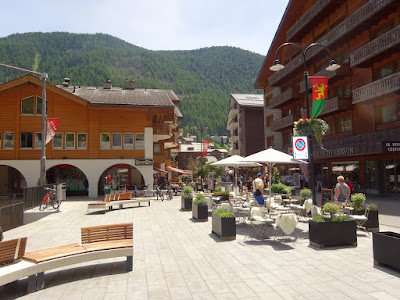Zermatt, population 5,800, is car-free. Residents can obtain a permit to park in one of the multi-level parking structures at the edge of town. For all others, it means coming up the mountain on the train or parking your car three miles down the mountain in the village of Taesch and hopping on the train.
Tucked away behind the horse carriages and the battery powered taxi in this photo is Zermatt's train station--where trains have been whisking people up and down the mountain since 1888.
This street will lead me to a view of the Matterhorn.
There's the Matterhorn in the distance.
Another view of the Matterhorn. At 14,692 feet, the Matterhorn is one of tallest in Europe. Over 500 have perished trying to reach its summit.
Looking back toward Zermatt's town center.
View up a hillside.
Tennis complex in center of town.
More of downtown Zermatt.
Filled my water bottle with ice cold water spewing from this water fountain carved out of the wood. Looks like a face with a hat.
Jeez, I snapped this photo to capture the temperature flashing below the Berdoz sign but it didn't come out. It showed 30 degrees celsius (90 degrees Fahrenheit). In the valley floor it was over 100 degrees.
Typical Zermatt taxi.
Parking structures at the edge of town for residents.
Here's the massive block-long parking structure three miles down the mountain from Zermatt. Behind it is a huge parking lot for tour buses. I count 30 buses.
It takes several hours to cycle down to the valley floor--passing quite a few waterfalls.
Lots of little villages along the way.




















































